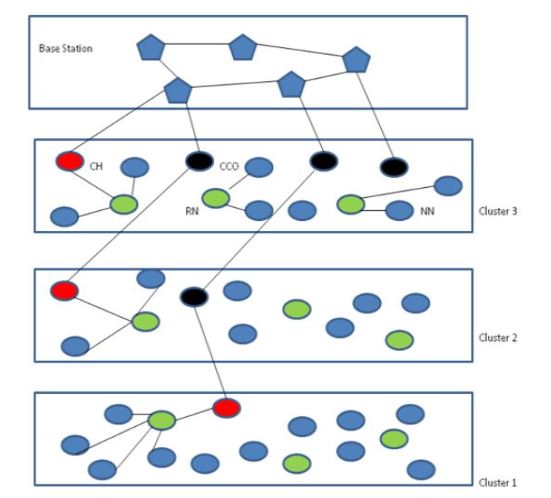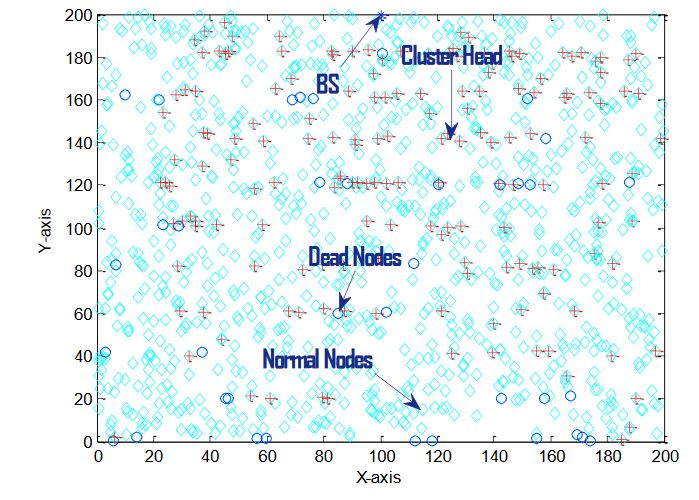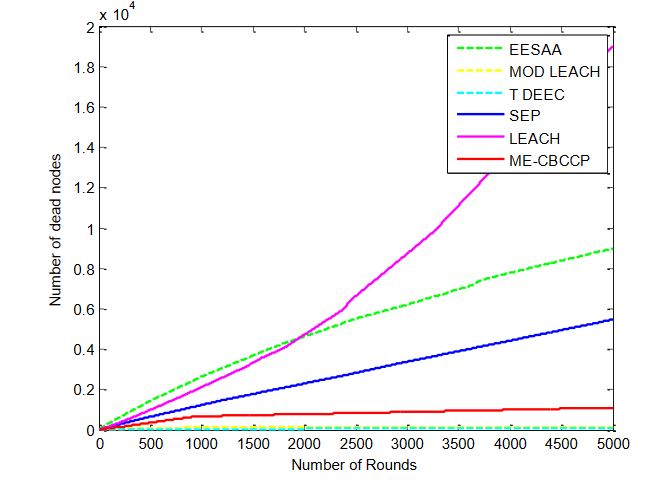ABSTRACT
One of the emerging networking standards that gap between the physical world and the cyber one is the Internet of Things. In the Internet of Things, smart objects communicate with each other, data are gathered and certain requests of users are satisfied by different queried data. The development of energy efficient schemes for the IoT is a challenging issue as the IoT becomes more complex due to its large scale the current techniques of wireless sensor networks cannot be applied directly to the IoT.
To achieve the green networked IoT, this paper addresses energy efficiency issues by proposing a novel deployment scheme. This scheme, introduces: (1) a hierarchical network design; (2) a model for the energy efficient IoT; (3) a minimum energy consumption transmission algorithm to implement the optimal model. The simulation results show that the new scheme is more energy efficient and flexible than traditional WSN schemes and consequently it can be implemented for efficient communication in the IoT.
RELATED WORK
A lot of research has already been reported for efficient communication in WSNs for the deployment of a green IoT, but little work is found concerning energy efficient communication for a scalable IoT. Routing protocols can be categorized into three types: (i) energy efficiency-based; (ii) reliability and network operation-based and (iii) network operation-based.
SYSTEM MODEL AND FRAMEWORK

Figure 1. Multi-tier Framework for IoT
Considering the above factors we propose static and energy efficient routing for a scalable and complex IoT. We studied the effect of using our transmission algorithm over a thousand nodes deployed in a 200 and 300 m 2 area with different numbers of nodes and found that static routing is really suitable for scalable IoT applications. We have used the same tiered framework as used, except for the relay layer which is not used in our framework, as can be seen in Figure 1. It presents the hierarchical network structure where all objects placed are static and follow the transmission based on static routing.
MODEL FOR AN ENERGY EFFICIENT IOT
With the above discussed framework and research problem, the main objective of ME-CBCCP is to reduce the communication distance between all the objects to compensate the power consumption in the lower layers of the IoT framework. In this section we have explored the various notations (Table 1) used in this paper and system constraints are formulated as per the requirements of an energy efficient IoT. Next, we address the optimization problem of an energy conserved IoT. To minimize the energy consumption in this framework, a minimal energy consumption transmission algorithm is proposed as a solution to the optimization problem.
PERFORMANCE EVALUATION AND RESULTS DISCUSSION

Figure 2. Smulation after 200 rounds of data transmission
The results discussed here a remeasured after approximately 95 simulations. Figure 2 shows the network after 200 rounds of data transmission. The number of CHs, relay nodes and CCOs will increase with the increase in the scale because with the increase in the size of the network, so a large number of coordinators will be required to connect and maintain the cooperative process. When the position of the BS and other nodes (RN, CH, CCO) is fixed, then less energy is consumed as there is no need to search again and again for these nodes. If the communication radius of the nodes is increased they can cover a large area, and then these nodes can be decreased in number in each layer.

Figure 9. Transmission delay
Figure 9, the results of transmission delay are shown in a large network and with the number of nodes. Results show that ME-CBCCP is performing better than other protocols. It is proved by these results that traditional protocols for WSNs cannot be applied to the IoT framework directly and they need to be modified.
CONCLUSIONS AND FUTURE SCOPE
Energy efficiency schemes have a significant role in developing an efficient IoT. In this paper, we have proposed an optimized solution to the problem of arranging objects in the implementation of an energy efficient and scalable IoT. Firstly, we gave the framework for the deployment of the IoT which has scalability features and makes it more extensible. Then, based on the framework, an optimization scheme which is constrained by the loads on wireless links and energy expenditure support the deployment of an energy efficient IoT.
Lastly the ME-CBCCP algorithm has been proposed based on the clustering topology as a solution to the optimization problem. With numerical experiments, it is validated that the proposed scheme is better than traditional WSN schemes in terms of time, network lifetime and scalability. It is found that that new scheme consumes six times less energy than LEACH, five times less energy than SEP, four times less energy than genetic HCR, three times less energy than ERP, three times less energy than MODLEACH, two times less energy than T-DEEC and 1.4 times less energy than EESAA which further validate our work.
It takes 23.22% less time than LEACH, 29% less time than SEP, 152 times less than ERP, 229 times than genetic HCR, 15% less time than EESAA, and 2 times less time than MODLEACH. In the future we will also try to exploit the benefits of heterogeneity and we will also propose improvements of end to end delay, data compression techniques, packet delivery ratios and throughput parameters, to achieve a more efficient green IoT.
Source: IKG Punjab Technical University
Authors: Shalli Rani | Rajneesh Talwar | Jyoteesh Malhotra | Syed Hassan Ahmed | Mahasweta Sarkar | Houbing Song
>> IoT based Networking Projects for Final Year Students
>> More Wireless Sensor Networks Projects Abstract for Engineering Students
>> More Wireless Energy Projects for Engineering Students